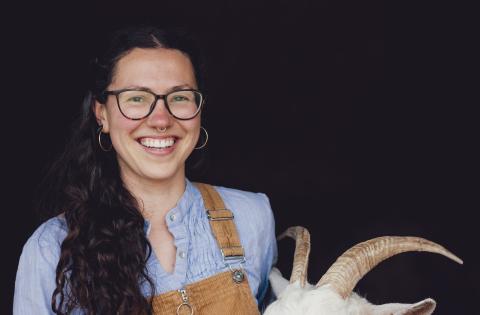First-generation farmer Sophia completed an organic dairy apprenticeship in Norway eight years ago, before moving back home to Wales where she set up her own dairy at a tenanted smallholding. She keeps dairy goats and Jersey cows on a pasture-based rotational grazing system. Calf and kid are at foot, milked once a day. The milk is processed on-farm into small batch products she sells direct. Ambitious to expand the herd and grow her market, her ultimate aim is to process and successfully market a speciality aged cheese.
“By visiting some of the leading farmhouse cheesemakers in Ireland, I will learn how they express the identity of their farms through their produce. My aim is to develop a unique aged Welsh cheese which showcases the herd health and biodiversity of my farm.”
EXECUTIVE SUMMARY
Dairy goat farmer to diversify into cheesemaking after research facilitated by Farming Connect
Producing a diversity of cheeses is key to smaller dairy farms making a success of this business diversification, according to research by one aspiring cheesemaker.
First generation tenant farmer Sophia Morgan-Swinhoe produces milk from a herd of goats and a micro herd of Jerseys on her farm near Machynlleth.
To add value to that milk, Sophia is planning to produce cheese and embarked on a Farming Connect Management Exchange study to inform her venture.
“For my exchange I was interested in how a dairy farmer can develop a cheese that reflects the region and farm it’s from,’’ she says.
She visited cheese producers in Ireland, including St Tola in County Clare, where milk comes from 200 Saanens, Toggenburg and British Alpine goats.
The farmer advised that, as a small dairy, diversity is key to success. “St Tola sell a mix of raw and pasteurised cheeses,’’ Sophia explains.
At Lost Valley Dairy, Cork, another of the farms she visited, cheese is produced from the milk of four dairy cows.
Both visits helped Sophia to understand that quality is what makes the cheese reflect the farm.
For Lost Valley Dairy that means microbially healthy raw milk, a starter developed on the farm, and ageing conditions
"Cheese is complex, there are many microbial and environmental factors that influence the taste of a cheese - terpens, acids, aldehydes and added microbes, mainly lactic acid bacteria, yeasts and moulds, that are part of the processing and maturing process,’’ says Sophia.
“Rather than seeing this as daunting a farmer looking to create a cheese has plenty of options for creating a product that will showcase their milk.’’
But there are many other considerations for aspirational cheese producers, including whether to produce raw or pasteurised varieties.
Cheeses made with raw milk are well received by cheesemongers and are in short supply in Wales.
“But when considering making a raw milk cheese the farmer should consider the receptiveness of their local Environmental Health Office and their willingness to add additional time onto milking to achieve the hygiene standards required for raw milk,’’ Sophia advises.
Herd health can also help a farmer make this decision - farms struggling with TB in high TB areas or herds with Johne’s should not opt for a raw milk cheese, she points out.
The size of the farming operation is another consideration.
“Farms with larger volumes of milk will have an easier time making hard cheeses,’’ says Sophia. “They will have the volume to make larger batches and they have a longer shelf life for the larger volumes made.’’
It may be more economically beneficial for smaller farms to make younger, softer cheeses, Sophie suggests, as a higher weight of cheese is produced from milk used in comparison with a hard cheese.
Biodiversity of the land and access to quality grazing should also be taken into account.
“Both farms I visited feed lower amounts of grain than the average dairy farm and state the sensory quality of cheese is improved by a diverse animal diet,’’ says Sophia.
“Willingness to improve the range of species in a dairy animals diet will help create a superior product.’’
Consideration should also be given to incorporating local ingredients – for instance a farm near the sea could include seaweed or one surrounded by forestry to create a spruce bark-wrapped cheese.
As a direct result of the study, Sophia is planning to experiment with making a range of cheeses, selecting the one which she feels best reflects the farm.
Once she has done that she will work with the Food Hub to develop the process and organise a tasting session on her farm once the cheese is ready to be eaten.
MANAGEMENT EXCHANGE REPORT


